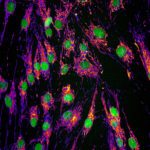Link to Pubmed [PMID] – 23042113
Nat. Genet. 2012 Nov;44(11):1282-5
A genetic bottleneck explains the marked changes in mitochondrial DNA (mtDNA) heteroplasmy that are observed during the transmission of pathogenic mutations, but the precise timing of these changes remains controversial, and it is not clear whether selection has a role. These issues are important for the genetic counseling of prospective mothers and for the development of treatments aimed at disease prevention. By studying mice transmitting a heteroplasmic single-base-pair deletion in the mitochondrial tRNA(Met) gene, we show that the extent of mammalian mtDNA heteroplasmy is principally determined prenatally within the developing female germline. Although we saw no evidence of mtDNA selection prenatally, skewed heteroplasmy levels were observed in the offspring of the next generation, consistent with purifying selection. High percentages of mtDNA genomes with the tRNA(Met) mutation were linked to a compensatory increase in overall mitochondrial RNA levels, ameliorating the biochemical phenotype and explaining why fecundity is not compromised.

